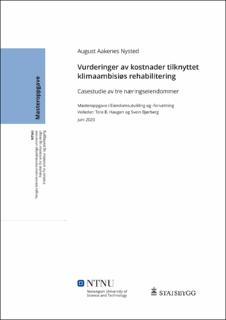| dc.contributor.advisor | Haugen, Tore Brandstveit | |
| dc.contributor.advisor | Bjørberg, Svein | |
| dc.contributor.author | Nysted, August Aakenes | |
| dc.date.accessioned | 2023-05-15T17:19:38Z | |
| dc.date.available | 2023-05-15T17:19:38Z | |
| dc.date.issued | 2020 | |
| dc.identifier | no.ntnu:inspera:61009049:44828512 | |
| dc.identifier.uri | https://hdl.handle.net/11250/3068013 | |
| dc.description.abstract | Verden er nødt til å håndtere global oppvarmning, større knapphet på naturressurser samt stigende befolkningstall. Norge har nasjonale klima- og miljøambisjoner om en gradvis omstilling, kalt «grønt skiftet», for å bli et lavutslippssamfunn innen 2050. Her er BAE-næringen sentral fordi de står for rundt 40 prosent av det globale energiforbruket og nesten 40 prosent av de totale direkte og indirekte CO2 utslippene. Av den totale bygningsmassen, er det eksisterende bygninger som er klimaverstingen. Rehabilitering av den eksisterende bygningsmassen er den meste hensiktsmessige løsninger for å bekjempe klimaproblemene.
Formålet med denne masteroppgaven er å øke kompetansen og kunnskapen rundt kostnader tilknyttet klimaambisiøs rehabilitering. På denne bakgrunn har følgende problemstilling blitt formulert: «Hvordan gjennomføres kost-/nyttevurderingene i klimaambisiøse rehabiliteringsprosjekt og hvilken påvirkning har dette for kostnadene og byggets restverdi?».
Masteroppgaven er skrevet som casestudie. Statsbyggs rehabiliteringsprosjekt av Statens vegvesens kontorsted i Steinkjer er brukt som masteroppgavens hovedcase, to caseobjekter er brukt som sammenlikningsgrunnlag. Dokumentanalyse, observasjon og intervjuer er gjennomført i forbindelse med casestudie. Totalt er det gjennomført åtte intervjuer.
De kvalitative og kvantitative forskningsprosessene er brukt som utgangspunkt for oppgavens resultatdel. Funnene viser til at kostnader er en helt sentral del for å gjennomføre en klimaambisiøs rehabilitering og utgjør en sentral del gjennom bygningers livsløp. Resultatdelen viser til at kostnadene i tidlig- og produksjonsfasen for klimaambisiøse rehabiliteringsprosjekter utgjør en liten merkostnad, men at disse kostnadene vil gi store besparelser i bruksfasen. I tillegg slår klimaambisiøs rehabilitering positivt ut på byggets restverdi.
Oppgaven konkluderer med at merkostanden for klimaambisiøs rehabilitering ikke er mye høyere enn å bygge etter byggeteknisk forskrift. For en passivhusrehabilitering er merkostnaden rundt 10 prosent høyere enn å bygge etter TEK10. Dette kommer blant annet av incentiv- og støtteordningene som reduserer investeringskostnadene. Klimaambisiøse rehabiliteringer vil erfare energi- og kostnadsbesparelsen rundt 50 prosent fra førtilstand. Masteroppgaven kunne ikke konkludere en spesifikk restverdi for klimaambisiøse rehabiliteringer. | |
| dc.description.abstract | Global warming, greater scarcity of natural resources and population growth are some of the socioeconomical issues the world needs to combat in the near future. Norway has strict climate- and environmental ambitions to not only cope with the situation but to thrive by becoming a low-emission society by 2050. Here the BAE-industry is of uttermost importance. The industry accounts for roughly 40 percent of global energy consumption and approximately 40 percent of total direct- and indirect CO2 emissions. One of the most effective ways to reduce energy consumption and CO2 emissions within the industry, is to refurbish the existing building stock.
This master’s thesis wants to examine the costs associated with climate ambitious refurbishment. To fulfil the purpose of this master’s thesis, the following research question has been developed: "How are the cost-/benefit analysis carried out in climate ambitious refurbishment projects and what impact does this have on the costs and the residual value of the building?".
A case study has been used as a research method. Three refurbishment projects have been investigated: Statsbygg’s refurbishment of The Norwegian Public Roads Administration in Steinkjer, KLP Eiendom’s refurbishment of Tempeveien 22 and Entra’s refurbishment of Schweigaards gate 15. Document analysis, observation and interviews were carried out as part of the case study. A total of eight interviews have been conducted.
The results are based on a qualitative and quantitative research processes. The findings could reveal that costs not only are a crucial part of carrying out climate ambitious refurbishment projects but also a constitute a central part throughout the entire life cycle of the building. In addition, climate ambitious refurbishment has a positive effect on the buildings residual value.
The thesis concludes that climate ambitious refurbishments have a slightly higher investment costs compared to similar projects built after the national building regulations. Passive houses are estimated to have a 10 percent higher investment costs compared to the regulations requirements from 2010, called TEK10. The small difference in investment costs is partly due to lucrative incentives and grants. On the contrary, climate ambitious refurbishments will experience energy- and cost savings of approximately 50 percent. Unfortunately, this master’s thesis did not have sufficient findings to come up with a specific residual value for climate ambitious refurbishments. | |
| dc.language | nob | |
| dc.publisher | NTNU | |
| dc.title | Vurderinger av kostnader tilknyttet klimaambisiøs rehabilitering | |
| dc.type | Master thesis | |
